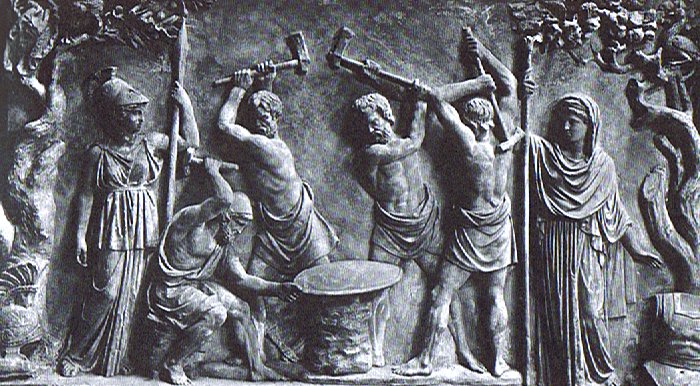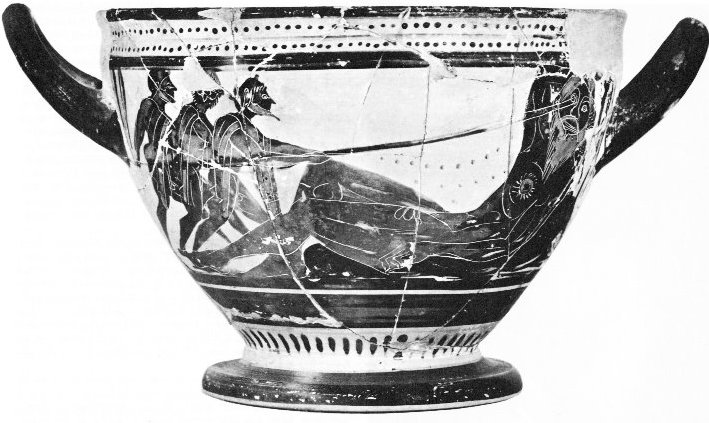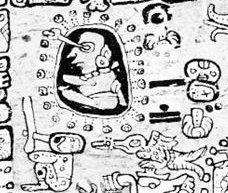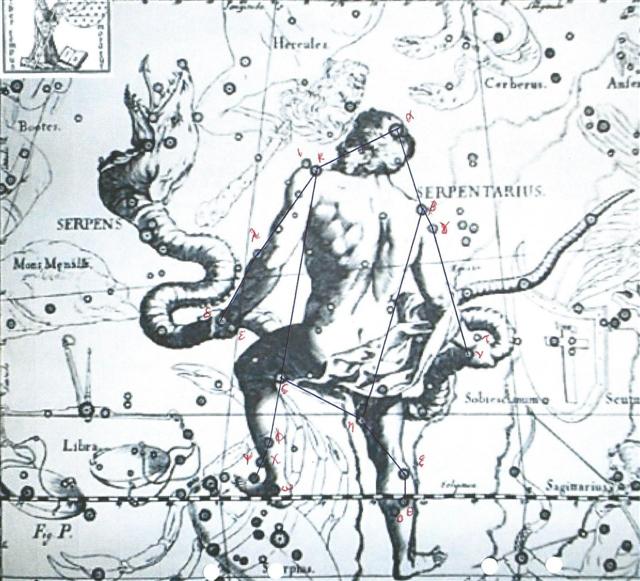404. The rongorongo texts seem to have their glyphs (and empty glyph spaces) arranged to be in parallel with the heliacal stars. Although at the hakaariki glyphs there might have been places where adjustments had to be made: ... In ancient times the priest-astronomers (Brahmans) determined the recurrence of the solstices and equinoxes by the use of the gnomon ... Or at least an explanation had to be given for why the new year did not 'ignite' instantaneously: ... Nut, whom the Greeks sometimes identified with Rhea, was goddess of the sky, but it was debatable if in historical times she was the object of a genuine cult. She was Geb's twin sister and, it was said, married him secretly and against the will of Ra. Angered, Ra had the couple brutally separated by Shu and afterwards decreed that Nut could not bear a child in any given month of any year. Thoth, Plutarch tells us, happily had pity on her. Playing draughts with the Moon, he won in the course of several games a seventy-second part of the Moon's light with which he composed five new days. As these five intercalated days did not belong to the official Egyptian calendar of three hundred and sixty days, Nut was thus able to give birth successively to five children: Osiris, Haroeris (Horus), Set, Isis and Nepthys ...
... The next three days his servants keep working the bellows: On the first day of their labour // He himself, smith Ilmarinen, // Stooped him down, intently gazing, // To the bottom of the furnace, // If perchance amid the fire // Something brilliant had developed. // From the flames there rose a crossbow, // Golden bow from out the furnace; // 'Twas a gold bow tipped with silver, // And the shaft shone bright with copper. // And the bow was fair to gaze on, // But of evil disposition // And a head each day demanded, // And on feast-days two demanded, // He himself, smith Ilmarinen, // Was not much delighted with it, // So he broke the bow to pieces, // Cast it back into the furnace. The next day, Ilmarinen looks anew: And a boat rose from the furnace, // From the heat rose up a red boat, // And the prow was golden-coloured, // And the rowlocks were of copper. // And the boat was fair to gaze on, // But of evil disposition; // It would go to needless combat, // And would fight when cause was lacking. Ilmarinen casts the boat back into the fire, and on the following day he gazes anew at the bottom of the furnace: And a heifer then rose upward, // With her horns all golden-shining, // With the Bear-stars on her forehead; // On her head appeared the Sun-disc. // And the cow was fair to gaze on, // But of evil disposition; // Always sleeping in the forest, // On the ground her milk she wasted. // Therefore did smith Ilmarinen, // Take no slightest pleasure in her, // And he cut the cow to fragments, // Cast her back into the furnace. The fourth day: And a plough rose from the furnace, // With the ploughshare golden-shining, // Golden share, and frame of copper, // And the handles tipped with silver. // And the plough was fair to gaze on, // But of evil disposition; // Ploughing up the village cornfields, // Ploughing up the open meadows, // Therefore did smith Ilmarinen // Take no slightest pleasure in it. // And he broke the plough to pieces, // Cast it back into the furnace, // Called the winds to work the bellows // To the utmost of their power. // Then the winds arose in fury, // Blew the east wind, blew the west wind, // And the south wind yet more strongly, // And the north winds howled and blustered. // Thus they blew one day, a second, // And upon the third day likewise. // Fire was flashing from the windows, // From the doors the sparks were flying // And the dust arose to heaven, // With the clouds the smoke was mingled. // Then again smith Ilmarinen, // On the evening of the third day, // Stooped him down, and gazed intently // To the bottom of the furnace, // And he saw the Sampo forming, // With its many-coloured cover ...
The Charioteer had no Sun horse:
And in the Golden Age of the Bull they had waited 16 days before they once again could observe Betelgeuze in day 104 = 88 + 16. ... Odysseus and his fleet were now in a mythic realm of difficult trials and passages, of which the first was to be the Land of the Cyclopes, 'neither nigh at hand, nor yet afar off', where the one-eyed giant Polyphemus, son of the god Poseidon (who, as we know, was the lord of tides and of the Two Queens, and the lord, furthermore, of Medusa), dwelt with his flocks in a cave. 'Yes, for he was a monstrous thing and fashioned marvelously, nor was he like to any man that lives by bread, but like a wooded peak of the towering hills, which stands out apart and alone from others.' Odysseus, choosing twelve men, the best of the company, left his ships at shore and sallied to the vast cave. It was found stocked abundantly with cheeses, flocks of lambs and kids penned apart, milk pails, bowls of whey; and when the company had entered and was sitting to wait, expecting hospitality, the owner came in, shepherding his flocks. He bore a grievous weight of dry wood, which he cast down with a din inside the cave, so that in fear all fled to hide. Lifting a huge doorstone, such as two and twenty good four-wheeled wains could not have raised from the ground, he set this against the mouth of the cave, sat down, milked his ewes and goats, and beneath each placed her young, after which he kindled a fire and spied his guests ...
The sooty terns were arriving to Easter Island at a time of the year which corresponded to early autumn north of the equator. It was possible to calculate where the stars would have stood at the time of the Bull and SEPTEMBER 29 (→ 9 * 29) alluded to glyph number 261, viz. to Ca10-6 (→ 60 as in the precessional distance down from the time of Gregory XIII to the time when Hyadum II had been at 0h - with an adjustment of 16 days due to how they anciently had waited for the return to visibility of the star to observe). 60 + 16 = 76 corresponded to 64 + 16 = 80 at the time of rongorongo, when the 'crooked canoe' of the Pope had been corrected by the precession. ... When the Pope Gregory XIII updated the Julian calendar he did not revise what had gone wrong before 325 AD (when the Council of Nicaea was held). Thus the stars were still 3-4 days 'out of tune' compared to the calendar ... the Gregorian 'canoe' was 'crooked'. His calendar was not in perfect alignment with the ancient star structure. Because he had avoided to adjust with the effects of the precession between the creation of the Julian calendar and the Council of Nicaea in 325 AD ... ... Taetagaloa [Not-Tagaroa] goes right over there and steps forward to the stern of the canoe saying - his words are these: 'The canoe is crooked.' (kalo ki ama). Instantly Likāvaka is enraged at the words of the child. Likāvaka says: 'Who the hell are you to come and tell me that the canoe is crooked?' Taetagaloa replies: 'Come and stand over here and see that the canoe is crooked.' Likāvaka goes over and stands right at the place Taetagaloa told him to at the stern of the canoe. Looking forward, Taetagaloa is right, the canoe is crooked. He slices through all the lashings of the canoe to straighten the timbers. He realigns the timbers. First he must again position the supports, then place the timbers correctly in them, but Kuikava the son of Likāvaka goes over and stands upon one support. His father Likāvaka rushes right over and strikes his son Kuikava with his adze. Thus Kuikava dies. Taetagaloa goes over at once and brings the son of Likāvaka, Kuikava, back to life. Then he again aligns the supports correctly and helps Likāvaka in building the canoe. Working working it is finished ...
But since first Julius Caesar and then the Pope had adjusted their calendars due to the precession since the time when the star figures had been placed in tune with the seasons (north of the equator) the date SEPTEMBER 29 above should correspond to September 29. My information above about early December is not to be understood as a reference to the factual month of December in the Gregorian calendar - these dates are no more than exhibiting to where the stars had been pushed ahead in the year due to the precession. Which means we can put in tune the heliacal stars at for instance OCTOBER 4 (Ca10-6) by looking at my right ascension day December 7, to where the precession would have pushed the stars which once upon a time had returned to visibility in OCTOBER 4.
In OCTOBER 4 the star ο Ophiuchi (above his right foot and down in the sweet waters of the Milky Way River, the Nile) would have returned to visibility, at the same time as when Alrisha (the Knot in Pisces) would have culminated at 21h. In the epoch of Bharani this 'toromiro star' would have risen heliacally in day 300 ("October 27), we can see, and in Roman times it would have risen 14 days later, in day 314 ('November 10). It makes sense to have a hakaariki glyph where Hercules was turned upside down and the Serpent Carrier took over (as viewed from north of the equator)..
|
||||||||||||||||||||||||||||||||||||||||||||||||||||||||||||||||||||||||||||||||||||||||||||||||||||||||||||||||||||||||||||||||||||||||||||||||||||||||||||||||||||||||||||||||||||||||||||||||||||||||||||||


















